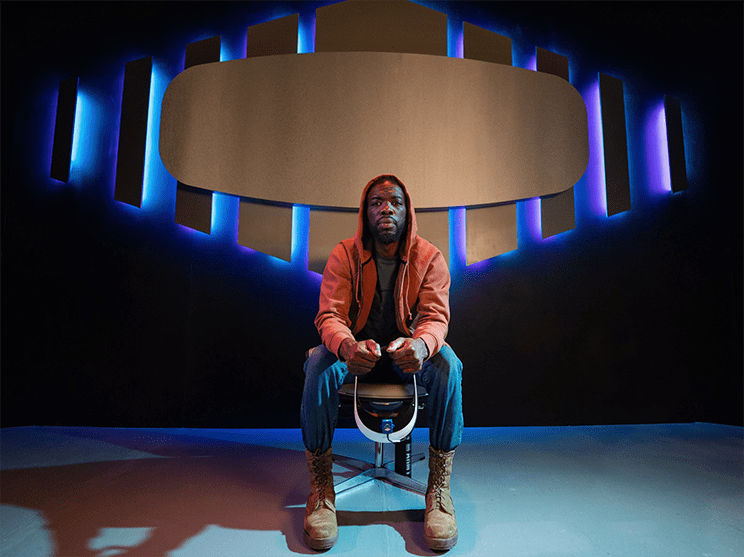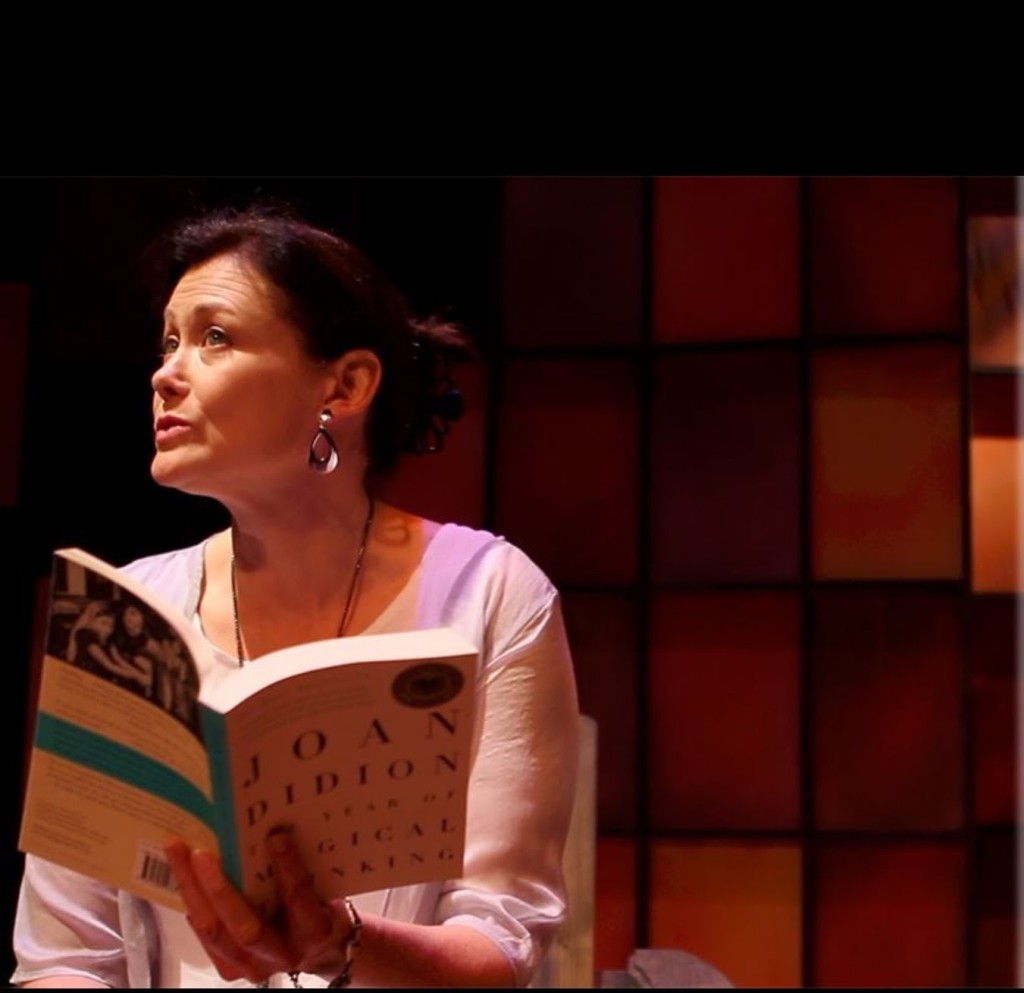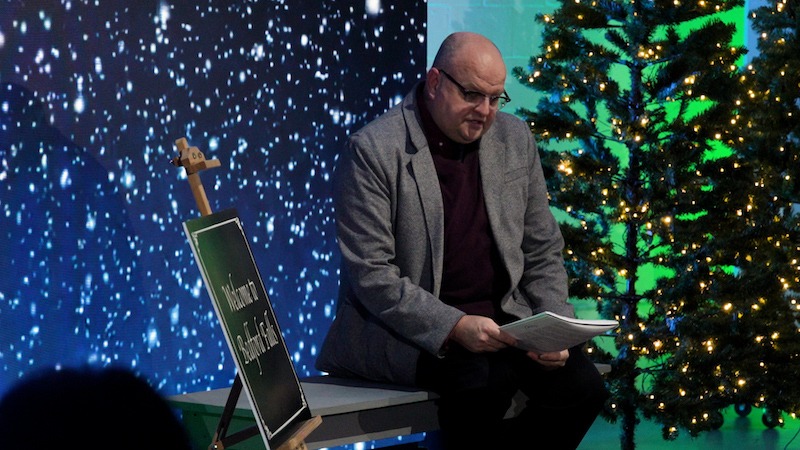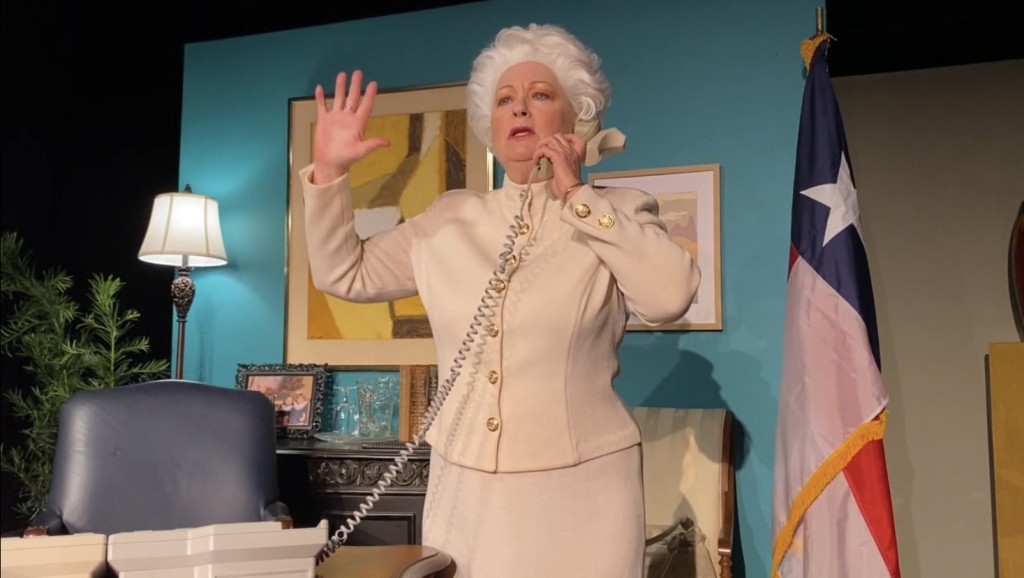By MARGO HAMMOND
NOTE: A version of this story was first posted in Arts Coast Magazine on April 25, 2023.
Remember the classic pitch--A Cast of Thousands!--that Hollywood used to seduce us into movie theater seats? Now stage theaters are luring us with "a cast of one."
Blame it on the COVID lockdown when we became accustomed to seeing actors one at a time in little square boxes. Blame it on the financial crisis facing theaters that have made them shy away from plays with large casts. Or just call it a trend. Here in West Central Florida in the past six months these type of plays have been flourishing.
Two of the plays with casts of one that I recently saw here illustrate another reason these plays are so popular here: They have been staged in small theatrical spaces which lend potency to the experience. Although many solo plays certainly have been performed successfully on proscenium stages, the distance between the audience and the stage at those more traditional venues works against the intimacy that one-person plays thrive on.
In December I went to see The Year of Extraordinary Travel, written and performed by Becca McCoy and directed by Vickie Daignault (I wrote about the experience for Arts Coast Journal; you can read my piece here) at the Studio Grand Central in St. Petersburg.
And in April I traveled to Sarasota to see Backwards Forwards Back by Jacqueline Goldfinger, performed by L. James and directed by Brendan Ragan, at the Urbanite Theater. Both venues are small black box theaters – Studio Grand Central seats 55, Urbanite seats 75.
At both of these plays, I watched a single actor on a nearly empty stage tell a very personal story in a very small space.
In Goldfinger’s Backwards Forwards Back that intimacy was crucial. Actor L. James plays a soldier returning from war. Seated in an armchair with a Virtual Reality headset, he talks to us about the VR therapy he is undergoing to rid him of his PTSD nightmares. A screen behind him projects the scenes he is seeing during his therapy – a desert, a burning building.
But it is the images of his war experience and its aftermath — including his detention of a boy whose entire family is annihilated by an incoming rocket and a harrowing scene at a Fourth of July celebration when he returns home — that remain with me still. They are the vivid images that James conjured up with his riveting performance just a few feet away from me.

In Backwards Forwards Back, a one-actor play at Urbanite Theater in Sarasota, L. James plays The Soldier, a man returning from war who is undergoing Virtual Reality therapy to try to deal with a severe case of PTSD.
That close proximity gave me an intense experience that a larger theater would have had difficulty to match.
Good actors, of course, can always project from a larger stage, but when it comes to one-person plays, size matters to me, I guess--the size of the theater, that is. Here's a case in point: I saw the play The Year of Magical Thinking, a one-woman play written by Joan Didion, based on her book of that title, three times--with three different actresses and in three different theaters. It was only when I saw it in a smaller venue, however, that I really got what Didion was trying to tell me.
The Year of Magical Thinking tells the story of Didion’s wrenching and disorienting year after her husband’s sudden death.The first time I saw the play was in 2007 in a Broadway production directed by David Hare at the massive 800-seat Booth Theatre. Vanessa Redgrave was playing the role of her friend Joan Didion. Didion was even in the audience that night. I had read the book and loved it. You would think all the ingredients for success were there. But the play left me cold.
Then in 2013 I saw that Roxanne Faye, a local actress I like, was offering the play at The Studio@620, a creative space in St. Petersburg. It was directed by one of The Studio’s founder, Bob Devin Jones. I decided to give the play another chance. When Faye delivered the opening lines, “… it will happen to you. The details will be different, but it will happen to you. That’s what I’m here to tell you,” I remember having the distinct impression that she was talking to me and me alone. The fact that I was sitting only a few feet away. I was deeply moved by the play this time. Was it the intimacy of the space that changed my experience of the play?
The positive impact a smaller space can have on the success of one-actor plays was reinforced when I saw The Year of Magical Thinking a third time in 2017, directed by Karla Hartley. This time Vickie Daignault, another local actress (now a director) I admire, took on the solo Didion role. It was held at the 99-seat Stageworks Theatre, the longest running theater in Tampa, where Hartley is producing artistic director. Again, the play worked for me.
All three actresses I saw in The Year of Magical Thinking made the work their own. Redgrave perhaps captured most accurately her friend’s demeanor as she faced down the emotions of grief. Faye showed me the normally cool Didion's struggle to fighting off those emotions. Daignault allowed me to see Didion’s open wound more clearly. Each embodied Didion’s grief and her difficulty in dealing with it.

Vickie Daignault in The Year of Magical Thinking at Stageworks Theatre
But it was the size of the venue where I saw that grief projected that made all the difference for me as a spectator. I could almost reach out and touch both Faye’s and Daignault’s anguish, which undid me, while Redgrave remained a remote figure to me.
There is another surprising ingredient that adds to the success of one-person plays for me, plays where a single actor holds me enthralled in a darkened space. At most of these plays I've seen, the single actor turns out to be only technically alone. Each time, an amazing number of people showed up onstage.
In Wonderful Life, St. Pete actor, drag performer and playwright Matt McGee, using his considerable acting chops summoned up no less than 15 characters. Actually, the entire cast of Frank Capra’s film It’s a Wonderful Life. American Stage producing director Helen R. Murray and Jason Lott adapted that classic film for this stage version.
With only a slight turn of his body or change of his voice, McGee transformed himself into George Bailey and George’s wife Mary and Mr Potter and George’s brother Harry and Uncle Billy and the floozy Violet and, of course, Clarence the Angel. There wasn’t a prop in sight (except that pair of glasses on Mr Potter).
McGee performed the engaging play in December at four locations here: The Studio Coastal Creative, and the James Museum (all spaces in St. Petersburg) and at Gulfport’s Catherine A. Hickman Theater. Earlier last year he appeared in a one-person play at freeFall, another St. Petersburg theater venue, portraying James Beard in I Love to Eat. Talk about earning your wings.

Matthew McGee bringing the town of Bedford Falls onstage in Wonderful Life
Or consider all the voices that I heard at Every Brilliant Thing, thanks to that play’s cleverly orchestrated interaction with audiences. The one-actor play by Duncan McMillan with Jonny Donahoe is about a six-year-old boy who began a list of brilliant things to convince his suicidal mother that life was worth living – and who continues to add to the list all his life.
In the script the actor is instructed to use members of the audience to shout out the items (which were printed on numbered slips of paper and distributed by the actor beforehand). The script also calls for audience members to be used as stand-ins for the people who populate this touching story (also negotiated by the actor before the play began).
So picture this – we are seated in the round at The Studio with actor Dylan Barlowe (who plays “the Narrator”) in the center. He is explaining to us how at six he came up with the idea for the list when he suddenly calls out “Number 1” (the first item on his infamous list) and the woman next to me exclaims, “Ice Cream.” Later, when Barlowe says “Number 4,” someone in the bleachers across the way yells out, “Laughing so hard you shoot milk out your nose.” And so on.
As he continues to tell us his heart-breaking but ultimately life-affirming story, his father, his school counselor Mrs. Patterson (and her sock puppet Booger), a lecturer and girlfriend Sam miraculously materialize, all thanks to audience members willing to play these parts. At one point, to cheer us up, Barlowe (who attended the Pinellas County Center for the Arts) even gets all of us to do the wave.

Dylan Barlowe bringing the audience into the story in Every Brilliant Thing
The audience also became part of the drama at Ann, which I saw in October, and Roshin’s Wake, which had its world premiere here in December. Ann, written by Holland Taylor who originated the role, begins with the governor addressing a graduating class. We in the audience are, of course, the stand-ins for the students.
At Roshin’s Wake, a story written and performed by Dorothy Hershman of an Irish immigrant traveling across the Western territories on the Oregon Trail – programs were handed out to us making it crystal clear that we were once again expected to play our part: “Imagine yourselves ‘In-Role” as fellow travelers on this wagon train.”
The Studio first presented Ann to sold-out crowds in the spring of 2022. In October the biographical play made famous by Holland Taylor on Broadway was back at The Studio by popular demand. All of the original creative team returned, headed by the indefatigable Bonnie Agan as Ann. Lisa Tricomi, who directed the Studio’s production, called the play “a love letter to democracy.”
Ann started out in the auditorium of a college graduation, but the setting quickly expanded to a convincing re-creation of the office of the governor of Texas (thanks to production stage manager Marcus Wehby), complete with American and Lone Star State flags.
There, Agan as Richards launched into a full, multi-tasking frenzy, yelling at her pokey speechwriter, giving a filmmaker a quote about abortion rights, telling a dirty joke, talking to Bill Clinton (who was then in the White House), ordering cowboy boots for her staff, debating whether she should issue a last-minute stay of execution, fixing the fringe on the American flag and acting as referee as she plans an outing with her kids.
At play’s end, I found myself with tears in my eyes, first from laughing so hard at Richard’s saucy personality and then in sorrow when Ann described her own funeral. It is a tribute to Agan’s gutsy performance to say that I would swear that there were dozens of other people onstage with her as she switched seamlessly from phone call after phone call to conversations with her assistant (who is a pre-recorded voiceover) to rants about the need for more political participation.

Bonnie Agan portraying Ann Richards on the detailed set designed by Marcus Wehby
In contrast to Ann’s elaborate office mise-en-scene, the setting for Roshin’s Wake was chillingly stark – just a tree stump and a wooden cross.
The stark stage setting for Roshin's Wake, and Dorothy Hershman, who wrote, directed, and performed Roshin’s Wake, during the play’s final talkback at The Studio@620 – photos by Margo Hammond
The play tells the story of Oognah Donohue whose daughter has just died in childbirth. When the play opens, Donohue is mourning at her daughter’s gravesite which she will soon have to abandon when the wagon train she is on moves westward.
And just as the program predicted, Dorothy Hershman, who wrote, directed and performed Roshin’s Wake (with a convincing Irish accent), addresses us directly as if we were indeed her fellow travelers, inviting us in the end to join the others for the Irish wake that they are holding to help her through her grief.
Hershman, an award-winning actor, moved to Gulfport from Texas in 2000 to take a job as a drama specialist for the lower grades at Berkeley Preparatory School in Tampa. It was there that she got her inspiration to write Roshin’s Wake.
When the 5th graders were learning about the Oregon Trail, she would help them do improvisations — or what she calls “process drama, exploring a subject by going into it and living it” — to make the period come alive for them. (Read her interview with Bill DeYoung in the Catalyst).
In 2015 she retired from Berkeley, but she never left the Oregon Trail. During the pandemic lockdown she tapped into the many years of research she had done on that period and wrote down the story she tells in Roshin’s Wake.
Roshin’s Wake was produced by Francine Wolf whose Largo-based ZaZu Productions L.L.C. created a promo for the play’s world premiere at The Studio@620.
Wolf herself is no stranger to one-woman performances. She presented her own solo play based on her life, Please Don’t Tell My Kids!, this month at the Tampa International Fringe Festival (and will be presenting it at the Fringe Fort Myers in June). Her Tampa performances were held at Screen Door, a 36-seat microcinema in the historic Kress building in Ybor City.

Poster for Francine Wolf’s solo play Please Don’t Tell My Kids!

